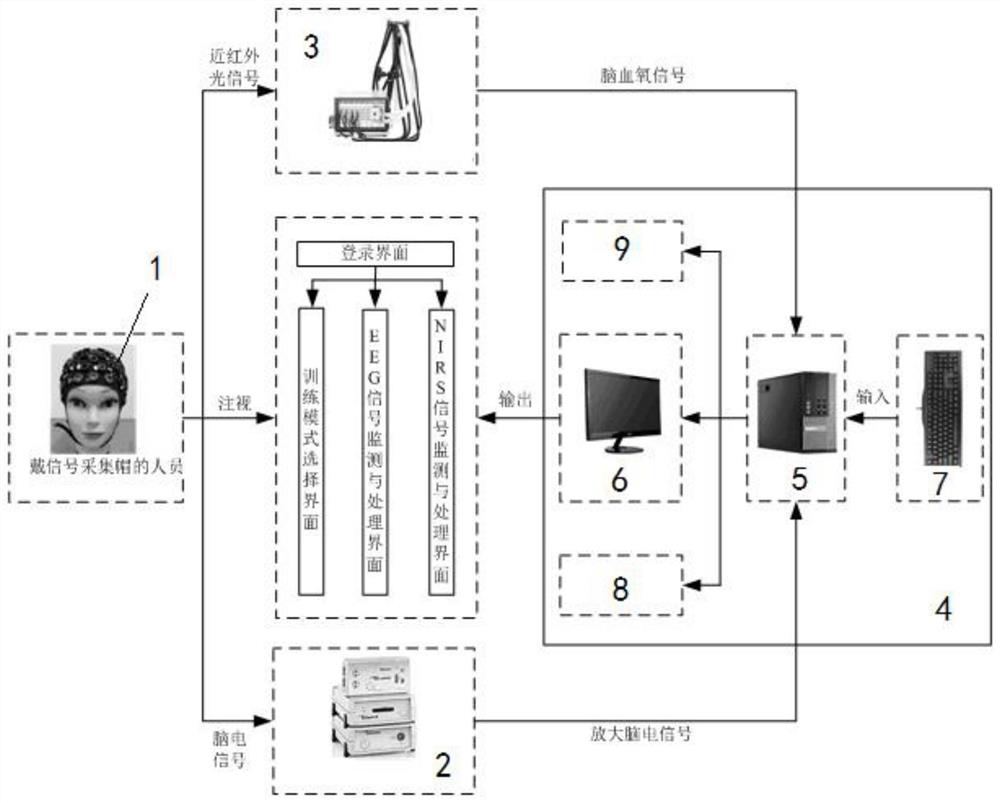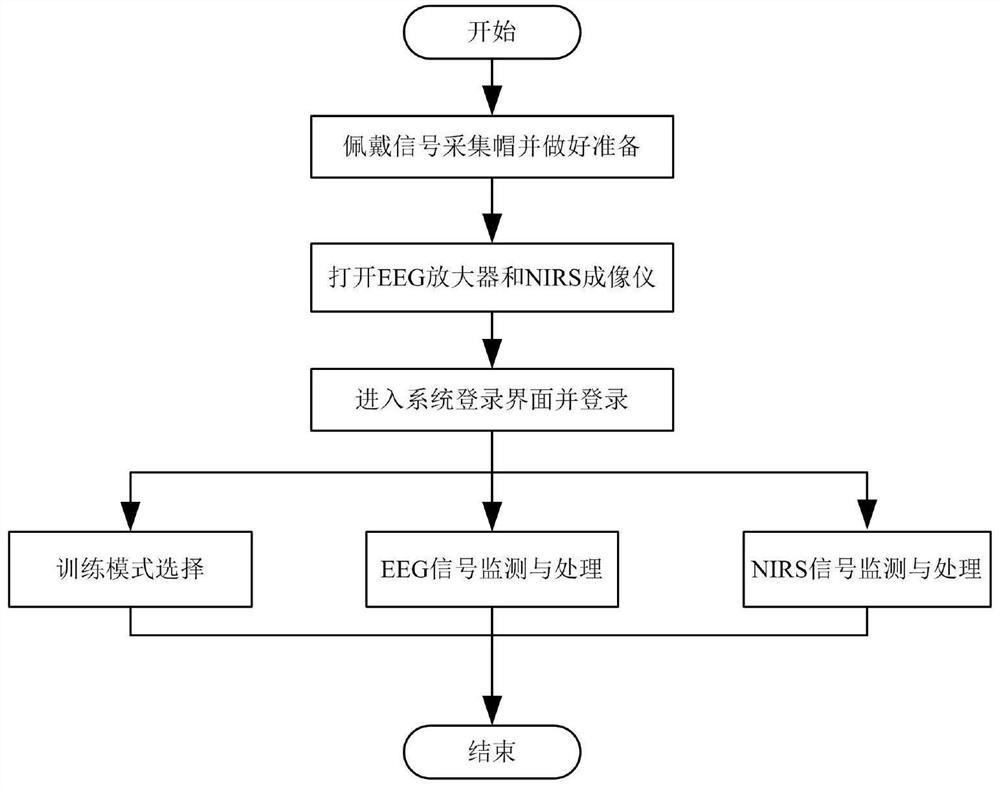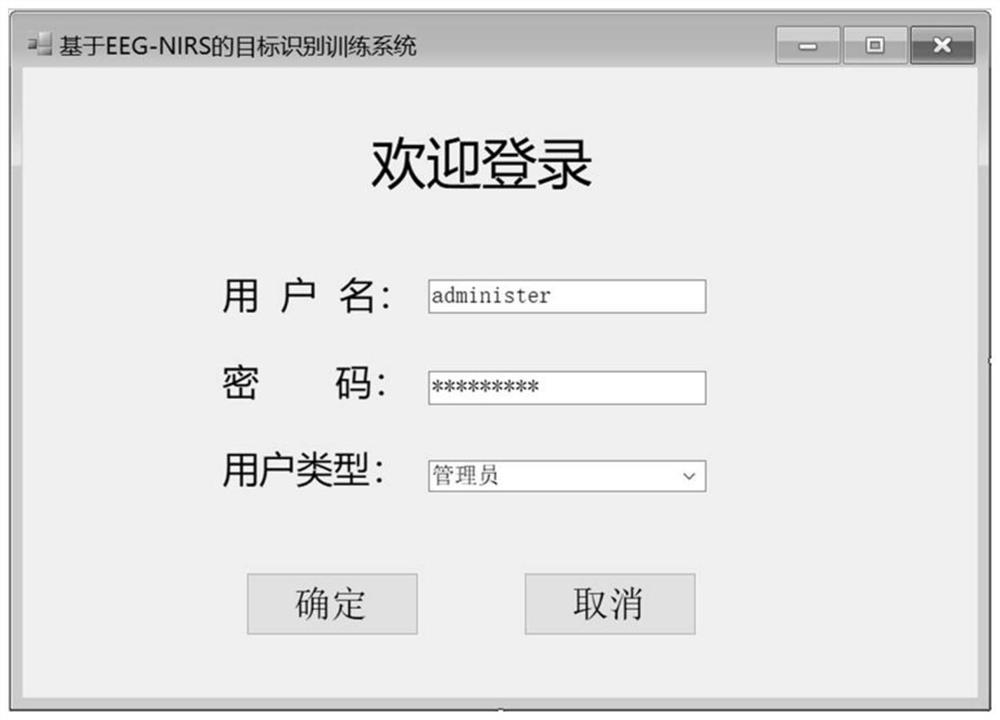Target recognition training system and method based on EEG-NIRS
A training system and target recognition technology, applied in character and pattern recognition, input/output process of data processing, input/output of user/computer interaction, etc. Recognition ability, low efficiency of manual recognition, etc.
- Summary
- Abstract
- Description
- Claims
- Application Information
AI Technical Summary
Problems solved by technology
Method used
Image
Examples
Embodiment 1
[0075] see figure 1, a target recognition training system based on EEG-NIRS, comprising a signal acquisition cap 1, an EEG signal amplifier 2, a near-infrared brain function imager 3 and a computer 4, characterized in that: the signal acquisition cap 1 is connected to the EEG signal The input end of the amplifier 2 and the input end of the near-infrared brain function imager 3; the signal of the host computer 5 of the computer 4 is connected to the output end of the EEG signal amplifier 2 and the output end of the near-infrared brain function imager 3; the computer 4 It consists of a host computer 5, a display 6, a keyboard 7, a P300 decoding unit 8, and a NIRS analysis unit 9. The display 6 displays the training system interface, and the user wears a signal collection cap 1 on his head and watches the information interface through the display 6. The EEG-based - The target recognition training system of NIRS calculates the target recognition rate of the user as an evaluation i...
Embodiment 2
[0078] This embodiment is basically the same as Embodiment 1, and the special features are as follows:
[0079] see figure 1 with figure 2 , the trainer wears the signal collection cap 1, opens the training system interface in the computer 4, and selects different training stages according to needs; after the training starts, based on the RSVP paradigm, the display interface randomly displays target pictures and non-target pictures at a set frequency , the trainers stare at the display interface, the EEG electrodes on the signal collection cap 1 collect the EEG signals of the trainers, and transmit them to the P300 decoding unit 8 in the computer 4 after being amplified by the EEG signal amplifier 2. 300 milliseconds after the target picture, the P300 EEG signal is induced, and the induced EEG signal is decoded through filtering processing, feature extraction and classification recognition algorithm. The decoding result is combined with the label information corresponding to...
Embodiment 3
[0083] This embodiment is basically the same as the above-mentioned embodiment, and the special features are as follows:
[0084] see figure 1 , the signal acquisition cap 1 is composed of EEG acquisition electrode part and near-infrared emitter and receiver part; EEG acquisition electrode part is wet electrode of 32 leads, through special parallel communication cable and EEG signal amplifier 2 connection, to transmit the collected EEG signals; the near-infrared transmitter and receiver are composed of 8 transmitters and 8 receivers, which form the collection area of 24 near-infrared optical channels, and connect with the near-infrared optical channel through a dedicated parallel communication cable. The brain function imager 3 is connected to transmit the collected near-infrared light signal.
[0085] see figure 1 , described computer 4, hardware part comprises: main frame 5, monitor 6 and keyboard 7; 3. The light signal data transmitted and the operating instructions tr...
PUM
 Login to View More
Login to View More Abstract
Description
Claims
Application Information
 Login to View More
Login to View More - R&D
- Intellectual Property
- Life Sciences
- Materials
- Tech Scout
- Unparalleled Data Quality
- Higher Quality Content
- 60% Fewer Hallucinations
Browse by: Latest US Patents, China's latest patents, Technical Efficacy Thesaurus, Application Domain, Technology Topic, Popular Technical Reports.
© 2025 PatSnap. All rights reserved.Legal|Privacy policy|Modern Slavery Act Transparency Statement|Sitemap|About US| Contact US: help@patsnap.com



